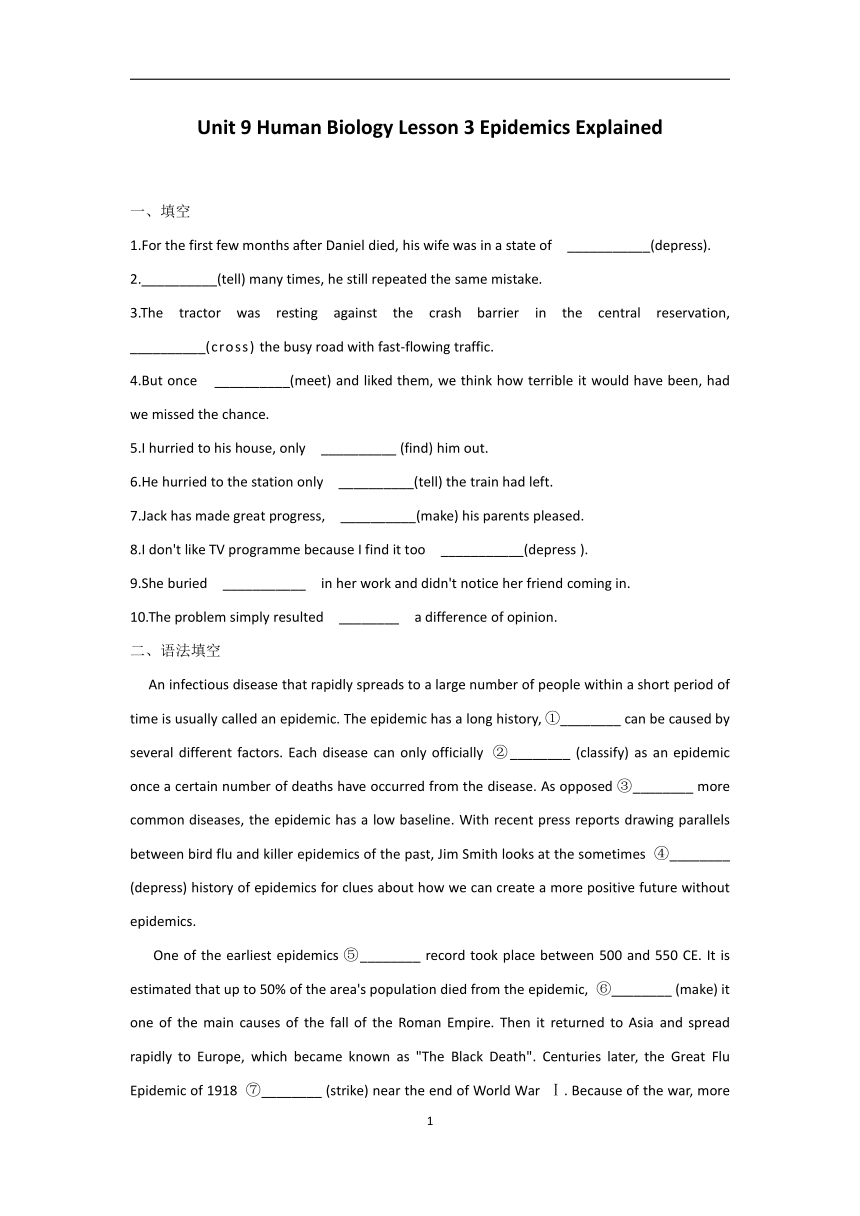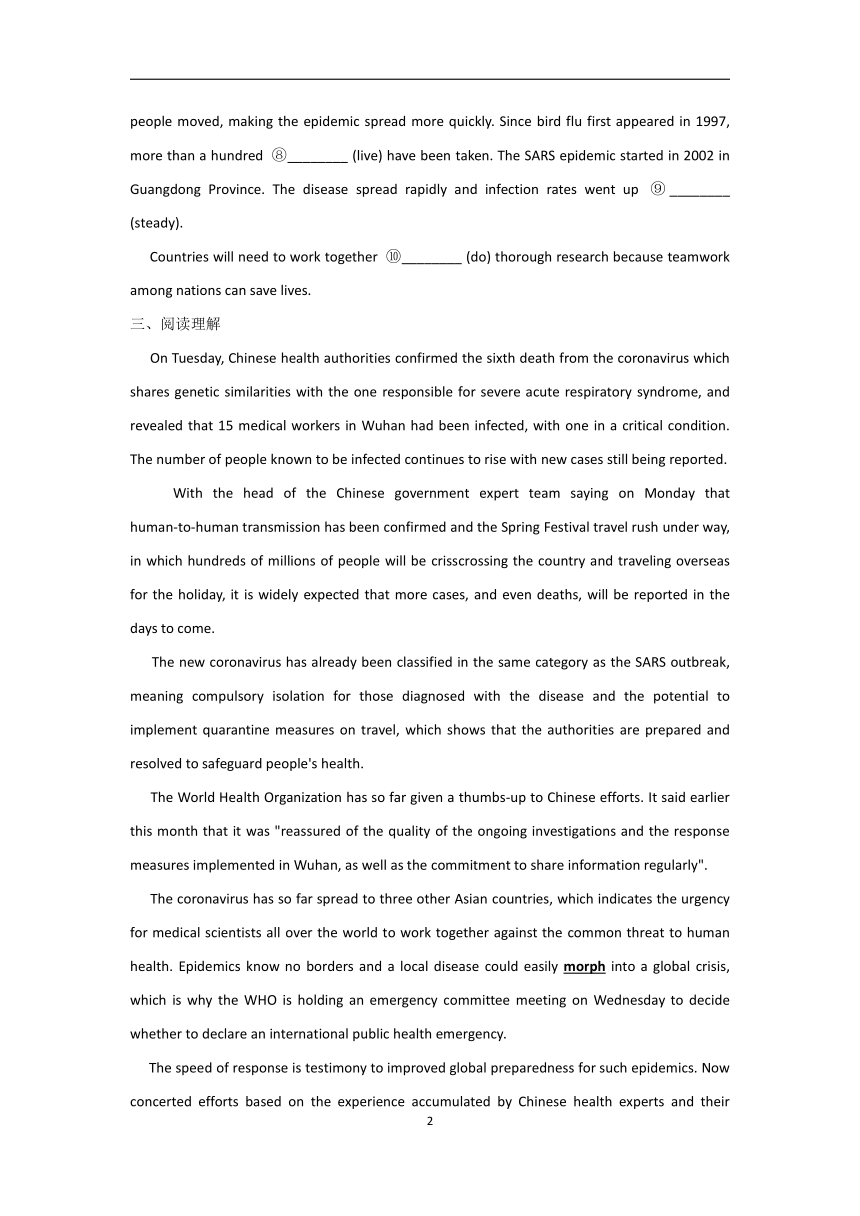北师大版(2019)选择性必修第三册同Unit 9 Human Biology Lesson 3 Epidemics Explained步课时作业(含答案)
文档属性
| 名称 | 北师大版(2019)选择性必修第三册同Unit 9 Human Biology Lesson 3 Epidemics Explained步课时作业(含答案) |

|
|
| 格式 | docx | ||
| 文件大小 | 22.0KB | ||
| 资源类型 | 教案 | ||
| 版本资源 | 北师大版(2019) | ||
| 科目 | 英语 | ||
| 更新时间 | 2023-05-05 22:08:35 | ||
图片预览


文档简介
Unit 9 Human Biology Lesson 3 Epidemics Explained
一、填空
1.For the first few months after Daniel died, his wife was in a state of ___________(depress).
2.__________(tell) many times, he still repeated the same mistake.
3.The tractor was resting against the crash barrier in the central reservation, __________(cross) the busy road with fast-flowing traffic.
4.But once __________(meet) and liked them, we think how terrible it would have been, had we missed the chance.
5.I hurried to his house, only __________ (find) him out.
6.He hurried to the station only __________(tell) the train had left.
7.Jack has made great progress, __________(make) his parents pleased.
8.I don't like TV programme because I find it too ___________(depress ).
9.She buried ___________ in her work and didn't notice her friend coming in.
10.The problem simply resulted ________ a difference of opinion.
二、语法填空
An infectious disease that rapidly spreads to a large number of people within a short period of time is usually called an epidemic. The epidemic has a long history, ①________ can be caused by several different factors. Each disease can only officially ②________ (classify) as an epidemic once a certain number of deaths have occurred from the disease. As opposed ③________ more common diseases, the epidemic has a low baseline. With recent press reports drawing parallels between bird flu and killer epidemics of the past, Jim Smith looks at the sometimes ④________ (depress) history of epidemics for clues about how we can create a more positive future without epidemics.
One of the earliest epidemics ⑤________ record took place between 500 and 550 CE. It is estimated that up to 50% of the area's population died from the epidemic, ⑥________ (make) it one of the main causes of the fall of the Roman Empire. Then it returned to Asia and spread rapidly to Europe, which became known as "The Black Death". Centuries later, the Great Flu Epidemic of 1918 ⑦________ (strike) near the end of World War Ⅰ. Because of the war, more people moved, making the epidemic spread more quickly. Since bird flu first appeared in 1997, more than a hundred ⑧________ (live) have been taken. The SARS epidemic started in 2002 in Guangdong Province. The disease spread rapidly and infection rates went up ⑨________ (steady).
Countries will need to work together ⑩________ (do) thorough research because teamwork among nations can save lives.
三、阅读理解
On Tuesday, Chinese health authorities confirmed the sixth death from the coronavirus which shares genetic similarities with the one responsible for severe acute respiratory syndrome, and revealed that 15 medical workers in Wuhan had been infected, with one in a critical condition. The number of people known to be infected continues to rise with new cases still being reported.
With the head of the Chinese government expert team saying on Monday that human-to-human transmission has been confirmed and the Spring Festival travel rush under way, in which hundreds of millions of people will be crisscrossing the country and traveling overseas for the holiday, it is widely expected that more cases, and even deaths, will be reported in the days to come.
The new coronavirus has already been classified in the same category as the SARS outbreak, meaning compulsory isolation for those diagnosed with the disease and the potential to implement quarantine measures on travel, which shows that the authorities are prepared and resolved to safeguard people's health.
The World Health Organization has so far given a thumbs-up to Chinese efforts. It said earlier this month that it was "reassured of the quality of the ongoing investigations and the response measures implemented in Wuhan, as well as the commitment to share information regularly".
The coronavirus has so far spread to three other Asian countries, which indicates the urgency for medical scientists all over the world to work together against the common threat to human health. Epidemics know no borders and a local disease could easily morph into a global crisis, which is why the WHO is holding an emergency committee meeting on Wednesday to decide whether to declare an international public health emergency.
The speed of response is testimony to improved global preparedness for such epidemics. Now concerted efforts based on the experience accumulated by Chinese health experts and their foreign counterparts during the joint fights against such epidemics as SARS, swine flu and avian flu are needed to win the fight against the latest health hazard.
1.What do we know about the coronavirus according to the passage
A.It is the same virus that led to SARA.
B.The Spring Festival travel rush will not worsen the control of the virus.
C.Whether it can be transmitted from person to person is still not known.
D.Carriers diagnosed with the virus should be quarantined.
2.What does the underlined word "morph" in Paragraph 5 mean
A.Translate. B.Crash. C.Change. D.Divide.
3.What is the WHO's attitude towards the efforts made by China
A.Dissatisfactory. B.Favorable. C.Pessimistic. D.Unpredictable.
4.What is the main idea of the last two paragraphs
A.The entire world is now being threatened with coronavirus.
B.The speed of response and preparation for emergency should be largely improved.
C.More experienced experts are needed to ensure the victory of the battle against the virus.
D.Combined efforts from home and abroad should be made to fight against the epidemics.
答案以及解析
一、填空
1.答案:depression
2.答案:Having been told
3.答案:having crossed
4.答案:having met
5.答案:to find
6.答案:to be told
7.答案:making
8.答案:depressing
9.答案:herself
10.答案:from
二、语法填空
答案:which ; be classified; to ; depressing; on ; making ; struck ; lives ; steadily; to do
三、阅读理解
答案:1-4 DCBD
解析: 1. 细节理解题。该题问的是根据文章,我们知道关于新冠病毒的什么信息。根据关键句可知,新冠病毒的携带者必须被强制隔离。故选D。
2. 词义猜测题。该题问的是第五段中的画线词morph是什么意思。根据关键句可知,流行病不分国界,地方性疾病很容易就会演变成全球性的疾病。由此可推知画线词应意为变成,转变,与C项意思一致。故选C。
3. 细节理解题。该题问的是世界卫生组织对中国所做的努力持什么态度。根据关键句可知,世卫组织对中国新冠病毒的防控工作表示赞许。故选B。
4. 段落大意题。该题问的是最后两段的主要内容是什么。通读最后两段尤其是关键句可知,文章最后两段主要讲述了战胜这场威胁人类健康的流行病需要海内外全体人士的共同努力。故选D。
2
一、填空
1.For the first few months after Daniel died, his wife was in a state of ___________(depress).
2.__________(tell) many times, he still repeated the same mistake.
3.The tractor was resting against the crash barrier in the central reservation, __________(cross) the busy road with fast-flowing traffic.
4.But once __________(meet) and liked them, we think how terrible it would have been, had we missed the chance.
5.I hurried to his house, only __________ (find) him out.
6.He hurried to the station only __________(tell) the train had left.
7.Jack has made great progress, __________(make) his parents pleased.
8.I don't like TV programme because I find it too ___________(depress ).
9.She buried ___________ in her work and didn't notice her friend coming in.
10.The problem simply resulted ________ a difference of opinion.
二、语法填空
An infectious disease that rapidly spreads to a large number of people within a short period of time is usually called an epidemic. The epidemic has a long history, ①________ can be caused by several different factors. Each disease can only officially ②________ (classify) as an epidemic once a certain number of deaths have occurred from the disease. As opposed ③________ more common diseases, the epidemic has a low baseline. With recent press reports drawing parallels between bird flu and killer epidemics of the past, Jim Smith looks at the sometimes ④________ (depress) history of epidemics for clues about how we can create a more positive future without epidemics.
One of the earliest epidemics ⑤________ record took place between 500 and 550 CE. It is estimated that up to 50% of the area's population died from the epidemic, ⑥________ (make) it one of the main causes of the fall of the Roman Empire. Then it returned to Asia and spread rapidly to Europe, which became known as "The Black Death". Centuries later, the Great Flu Epidemic of 1918 ⑦________ (strike) near the end of World War Ⅰ. Because of the war, more people moved, making the epidemic spread more quickly. Since bird flu first appeared in 1997, more than a hundred ⑧________ (live) have been taken. The SARS epidemic started in 2002 in Guangdong Province. The disease spread rapidly and infection rates went up ⑨________ (steady).
Countries will need to work together ⑩________ (do) thorough research because teamwork among nations can save lives.
三、阅读理解
On Tuesday, Chinese health authorities confirmed the sixth death from the coronavirus which shares genetic similarities with the one responsible for severe acute respiratory syndrome, and revealed that 15 medical workers in Wuhan had been infected, with one in a critical condition. The number of people known to be infected continues to rise with new cases still being reported.
With the head of the Chinese government expert team saying on Monday that human-to-human transmission has been confirmed and the Spring Festival travel rush under way, in which hundreds of millions of people will be crisscrossing the country and traveling overseas for the holiday, it is widely expected that more cases, and even deaths, will be reported in the days to come.
The new coronavirus has already been classified in the same category as the SARS outbreak, meaning compulsory isolation for those diagnosed with the disease and the potential to implement quarantine measures on travel, which shows that the authorities are prepared and resolved to safeguard people's health.
The World Health Organization has so far given a thumbs-up to Chinese efforts. It said earlier this month that it was "reassured of the quality of the ongoing investigations and the response measures implemented in Wuhan, as well as the commitment to share information regularly".
The coronavirus has so far spread to three other Asian countries, which indicates the urgency for medical scientists all over the world to work together against the common threat to human health. Epidemics know no borders and a local disease could easily morph into a global crisis, which is why the WHO is holding an emergency committee meeting on Wednesday to decide whether to declare an international public health emergency.
The speed of response is testimony to improved global preparedness for such epidemics. Now concerted efforts based on the experience accumulated by Chinese health experts and their foreign counterparts during the joint fights against such epidemics as SARS, swine flu and avian flu are needed to win the fight against the latest health hazard.
1.What do we know about the coronavirus according to the passage
A.It is the same virus that led to SARA.
B.The Spring Festival travel rush will not worsen the control of the virus.
C.Whether it can be transmitted from person to person is still not known.
D.Carriers diagnosed with the virus should be quarantined.
2.What does the underlined word "morph" in Paragraph 5 mean
A.Translate. B.Crash. C.Change. D.Divide.
3.What is the WHO's attitude towards the efforts made by China
A.Dissatisfactory. B.Favorable. C.Pessimistic. D.Unpredictable.
4.What is the main idea of the last two paragraphs
A.The entire world is now being threatened with coronavirus.
B.The speed of response and preparation for emergency should be largely improved.
C.More experienced experts are needed to ensure the victory of the battle against the virus.
D.Combined efforts from home and abroad should be made to fight against the epidemics.
答案以及解析
一、填空
1.答案:depression
2.答案:Having been told
3.答案:having crossed
4.答案:having met
5.答案:to find
6.答案:to be told
7.答案:making
8.答案:depressing
9.答案:herself
10.答案:from
二、语法填空
答案:which ; be classified; to ; depressing; on ; making ; struck ; lives ; steadily; to do
三、阅读理解
答案:1-4 DCBD
解析: 1. 细节理解题。该题问的是根据文章,我们知道关于新冠病毒的什么信息。根据关键句可知,新冠病毒的携带者必须被强制隔离。故选D。
2. 词义猜测题。该题问的是第五段中的画线词morph是什么意思。根据关键句可知,流行病不分国界,地方性疾病很容易就会演变成全球性的疾病。由此可推知画线词应意为变成,转变,与C项意思一致。故选C。
3. 细节理解题。该题问的是世界卫生组织对中国所做的努力持什么态度。根据关键句可知,世卫组织对中国新冠病毒的防控工作表示赞许。故选B。
4. 段落大意题。该题问的是最后两段的主要内容是什么。通读最后两段尤其是关键句可知,文章最后两段主要讲述了战胜这场威胁人类健康的流行病需要海内外全体人士的共同努力。故选D。
2
